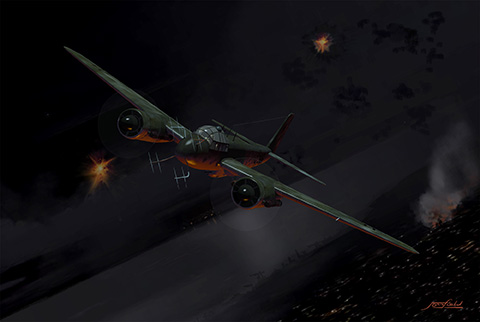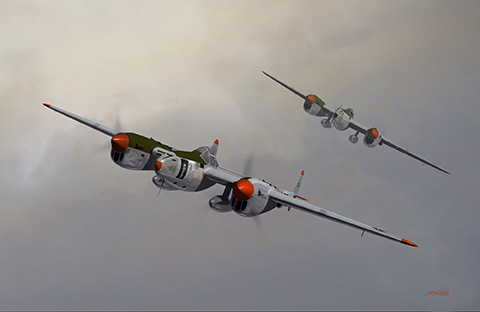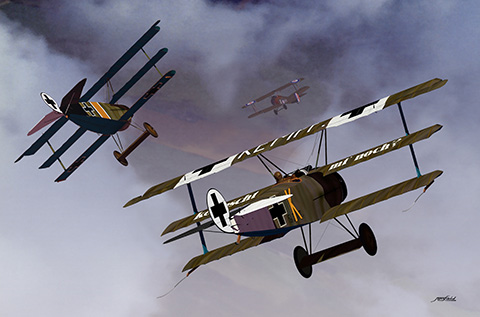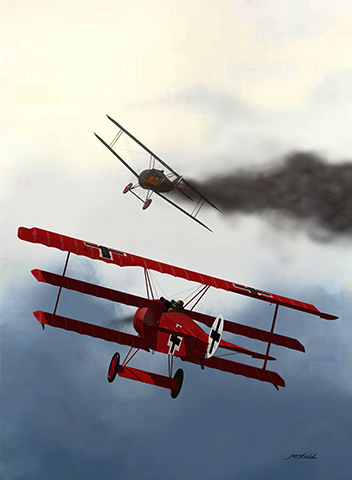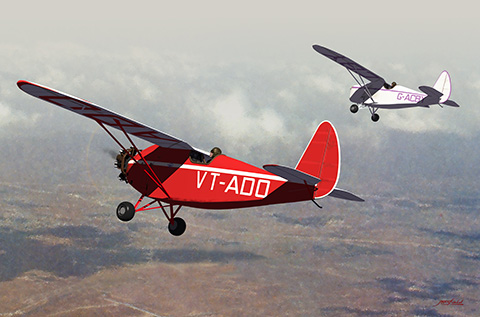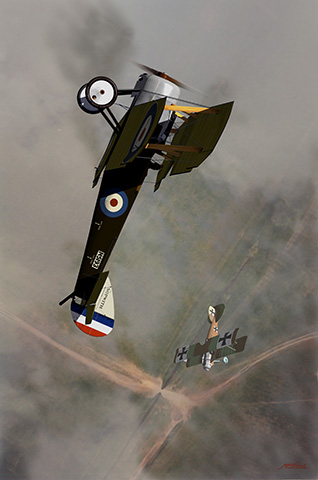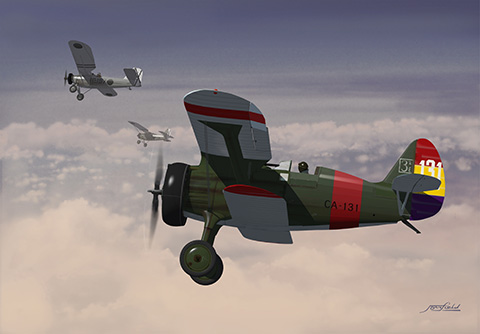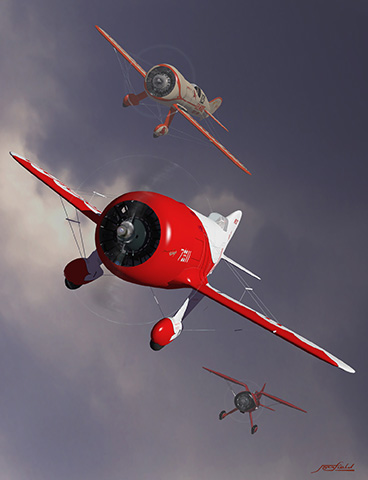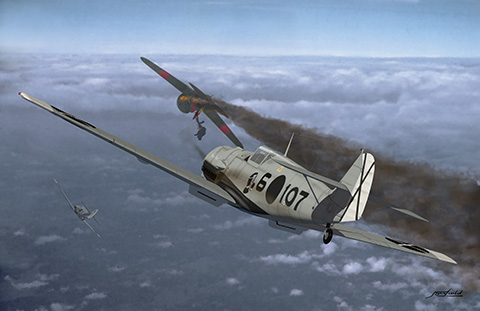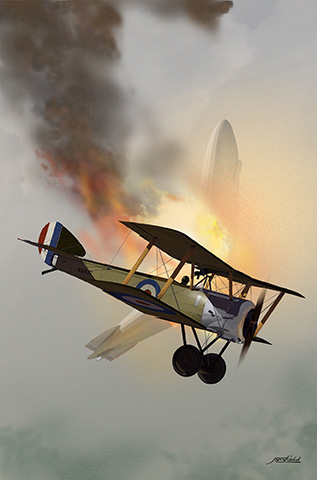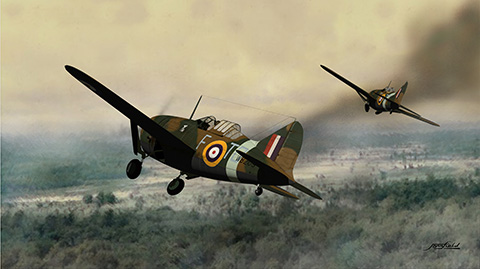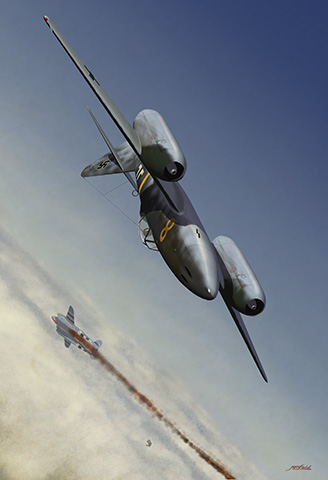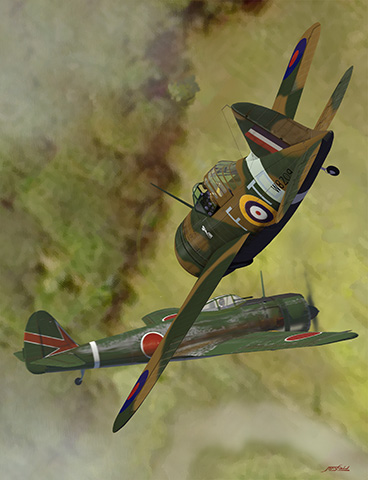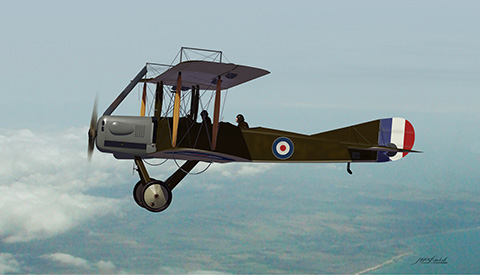Gallery
To view the pictures in more detail, just roll your mouse over the image to magnify it.
Please remember whilst viewing these images, that no two monitors are the same and therefore yours may display the colours differently from the finished print.
Overall Print Sizes are: 19.01 by 12.95 inches (483mm by 329mm)
The Darkest Hour
This illustration depicts Ofw Heinz Hommel of III./NJG 2 in his Junkers Ju 88G-6, 4R+MR, just after releasing his bombs over East Hull at about 2150 hours on Saturday 17 March 1945. He later claimed to have shot down a Lancaster bomber shortly afterwards, which crashed at Sunk Island.
Looking For Trouble
Richard I. Bong was America's most decorated fighter Ace and achieved a total of 40 confirmed victories against the Japanese, making him the highest scoring fighter pilot of World War 2. He and his friend Tom Lynch (who died with 20 kills to his credit) were allowed to freelance and look for targets of opportunity over the Pacific.
For a time Bong was flying this P38 Lightning which he called "Marge" (after his sweetheart, later to become his wife) with a huge colour photograph of her doped on its nose.
Image Size: 17.87 by 11.61 inches (454mm by 295mm) 
With Help From My Little Friends
'Oh Kay!' was a B17G of 457th Bomb Group piloted by Lt. Bernard V Connor and Lt. John W Norton. During a bombing run over Dessau in May 1944 they lost 2 engines after a Luftwaffe attack. Nevertheless, mission completed, they turned for home with a damaged compass.
They were picked up heading in the wrong direction by some 'Little Friends' (the bomber crew's slang for fighters.) They were P38's of the 364th Group out of Honington on their 2nd mission of the day, escorting stragglers to safety. The damaged plane was safely accompanied to the Channel and made its way home, arriving 2 hours late.
Image Size: 17.87 by 10.04 inches (454mm by 255mm) 
Ambush
1918. A straggling Sopwith Camel is ambushed by two members of Jasta Boelcke.
Lt. Friedrich Kempf is flying his famous Fokker Dr1 with his name blazoned across the center of the top wing. His middle wing carries the legend, 'kennscht mi noch?' which translates to something like 'do you remember me?' This has often been thought of as an arrogant war cry, but was apparently a tongue in cheek jibe intended for his comrades as Kempf had been on extended leave.
Image Size: 17.87 by 11.81 inches (454mm by 300mm) 
Richthofen's Last
Manfred von Richthofen attacked a large number of aircraft from 3 Squadron RAF on the 20th April 1918. With a few shots he despatched Richard Raymond-Barker in his Sopwith Camel. Three minutes later he engaged another Camel flown by 2nd Lt. David Lewis of the same squadron. He too was shot down in flames.
Richthofen assumed he had killed both pilots, but Lewis survived the war. These were Richthofen's 79th and 80th kills. The next day Richthofen was hit and killed by ground fire. So ended the reign of the Red Baron.
Image Size: 12.40 by 17.87 inches (315mm by 454mm) 
Five Miles Out
On the 5th of February 1939, Alex Henshaw took off from Britain and on the 6th landed at Wingfield Aerodrome, Capetown, after flying 6377.9 miles in 39 hours 25 minutes at an average speed of 209.44 mph.
After resting for 27 hours he was back in the air for the return journey which took only 11 minutes longer. This was the fastest time for any aircraft or crew from Capetown to England. It reduced the existing solo record by 66 hours and 42 minutes. Not only were all the Capetown and return records broken, but also for every en route too, and remains so in the solo classification to this day. An epic achievement.
Image Size: 17.87 by 11.81 inches (454mm by 300mm) 
Migration
George Stead and Alban Ali flying in loose formation to England.
They had just competed in the 1933 Viceroy Challenge Trophy Race at New Delhi where Stead had clocked up the fastest time in the race and Alban Ali got the second fastest. Stead was flying a Comper Swift with Gypsy engine owned by Richard Shuttleworth.
Alban Ali, an Assam tea planter was flying his Pobjoy engined Swift named 'Scarlet Angel.' However Alban Ali's plane had ingested so much sand and dust he was forced to abandon the trip to England and the pair parted company at Cairo. 'Scarlet Angel,' completed its journey in a crate and was subsequently sold.
Today this plane forms part of the Shuttleworth Collection and can be seen flying at Old Warden.
Image Size: 17.87 by 11.81 inches (454mm by 300mm) 
Todd's Last Battle
Just into the new year of 1917, Flight Lt. Todd of 8 Naval Squadron broke away from his four companions and single handedly engaged three Albatros D2's of Jasta 2 Boelcke. One of the German pilots was Manfred von Richthofen and Todd's aircraft was the first Sopwith Pup he'd encountered.
In his subsequent combat report Richthofen commented - "We saw immediately that the enemy plane was superior to ours. Only because we were 3 to 1 did we detect the enemy's weak points and I managed to get behind him and shoot him down."
Therefore on the 4th January 1917 Richthofen secured his 16th victory.
Image Size: 11.81 by 17.87 inches (300mm by 454mm) 
Red Star Rising
573 was one of the Mig-15bis of the Soviet Air Force's first jet display team, unofficially known as 'the Red Five' formed at Kubinka AB in 1950.
Image Size: 12.12 by 17.87 inches (308mm by 454mm) 
They Also Serve
This Avia FL3 was purchased from Italy by the Air Force of the Independent State of Croatia. They were intended for use in anti partisan activities presumably as spotter aircraft as they carried no armament.
This picture shows the Avia observing two Croatian Bf109's as they patrol the mountains just before the end of the war.
Image Size: 17.87 by 11.81 inches (454mm by 300mm)
"Curtiss! Curtiss!"
When this pugnacious little fighter, the Polikarpov I15, first appeared in the skies above Civil War torn Spain, the Nationalists called it a Curtiss, convinced it must be an American aircraft. They wrongly assumed the Russians were not capable of producing such a potent machine.
Image Size: 17.87 by 12.40 inches (454mm by 315mm) 
Doolittle Triumphant - 1932
The National Air Races of 1932 were held at Cleveland Municipal Airport, Ohio.
While preparing his Laird Super Solution for the Thompson Trophy Race, Jimmy Doolittle encountered undercarriage problems and damaged his aircraft in a forced landing.
Russ Boardman, the pilot originally chosen to fly the GBR1 was severely injured as he spun a model E Sportster into trees while on his way to complete tests on the revamped GBR1 prior to the race. Unfortunately Boardman was injured and unable to compete. So, Jimmy Doolittle was without a plane and the GBR1 had lost its pilot.
Doolittle was offered the opportunity to fly the GBR1 by the Granville Brothers in this historic race. He lapped every other competitor and won with a speed of 252.686 mph.
The GBR1 also set an incredible world record at this race meeting of 296.287 mph (One pass was better than 309mph!)
This record stood for 4 years. A mighty man. A mighty aircraft.
Image Size: 11.57 by 15.12 inches (294mm by 384mm) 
Rat Catchers
When the Bf109 arrived in Spain during the Civil War, it was arguably the best fighter in the world. Here we see a Bf109E-4, scripted 'Mors-Mors,' overtaking a stricken Polikarpov I16 nicknamed 'La Rata,' by the Nationalists. Despite its superiority, the Bf109 could still be vulnerable to this tough, agile fighter.
Image Size: 17.87 by 11.57 inches (454mm by 294mm) 
David and Goliath
In 1917 the Royal Navy was preoccupied with the thought of bringing the enemy High Seas Fleet to battle and recognized the menace posed to its operations by the reconnaissance Zeppelins used by the German Navy.
On the morning of 21st August 1917, Zeppelin L23 was sighted. HMS Yarmouth having been fitted with a special "fly off" platform launched one of her Beardmore built Sopwith Pups - flown by Second Lieutenant B.A.Smart.
Smart climbed above the L23 and dived to attack it. As Smart broke off his attack, he saw the Zeppelin going down in flames. With no provision for landing back on ship, Smart had to ditch his aircraft, but was picked up safely. The Pup however, could not be recovered. No survivors of the L23 were found.
This was the first time an aircraft had taken off from a moving ship to engage the enemy. Smart was awarded the DSO for this action.
Image Size: 11.81 by 17.87 inches (300mm by 454mm) 
Buffalo Boys, Won't You Come Out Tonight?
With no early warning, the Japanese could drop their bombs at height and speed with no resistance. Therefore when the Brewster Buffalos scrambled to retaliate, the enemy had vanished. Here I imagine 2 Brewster Buffalo Mark 1s of 453 Squadron over Singapore in hot pursuit of their adversaries, long-gone. Sergeant Read is flying W8209, canopy open due to the sultry heat, and sporting a picture of the Man Magazine cartoon character "Snifter" on the aircrafts side.
Read was later to lose his life when he famously rammed a Japanese Ki-43.
Image Size: 17.87 by 10.00 inches (454mm by 254mm) 
Lightning Strikes
On the 26th of November 1944, Herman Buchner claimed his first jet victory in the ME262 when he shot down a P38 Lightning flown by Lt. Irvin Rickey of the 7th PRG in an attack so devastating and undertaken at such speed that the american believed he had been hit by flak. Rickey survived the war as a P.O.W.
Image Size: 11.10 by 17.87 inches (282mm by 454mm) 
The Inspection
RNAS Sopwith 1� strutters of 3 Wing at Luxeuil, sometime in late 1916. This Sopwith quickly earned a reputation as a superb bomber, escort fighter, and reconnaissance aircraft.
The three aircraft in this picture are being subjected to an informal inspection by a inquisitive French naval Nieuport XV11. On its rudder it sports an anchor and has the black eagle emblem on its side.
Image Size: 17.87 by 12.00 inches (454mm by 305mm) 
Not On My Watch
Singapore 1941. Sergeant Read, a New Zealander flying a British Model 339E Brewster Buffalo Mark 1 of 453 Squadron had expended all his ammunition in combat. In an extraordinary act of bravery he rammed a Japanese Nakajima Ki-43 Oscar.
Both pilots lost their lives.
Image Size: 11.57 by 15.08 inches (294mm by 383mm) 
White Eagles Revenge
On the 20th of August 1940, a lone Ju88 A1 of 8 Staffle KG30, intending to drop its bombs on Hull, was intercepted by six Hurricanes of Green flight based at Lecenfield. This Polish squadron had only been formed the previous day. It must have seemed sweet retribution as it was the first opportunity for the Polish pilots to hit back after the fall of Poland. The Ju88 was shot down and crashed into a field at Otteringham. Three of its crew bailed out and were made P.O.W.'s.
Image Size: 17.87 by 10.24 inches (454mm by 260mm) 
Testing Times - T1 Maiden Flight, 1917
Prior to August 2004, only one photograph of this aircraft was thought to exist by the aviation world. A chance meeting in a Cumbrian cafe put the artist at the next table to Tim Neat, the designer's grandson.
After an enthusiastic discussion Tim commissioned Jon to paint this picture of his grandfather's aircraft, the Saunders T1, and supplied him with both scale drawings and glass slides from his grandfather's collection. This collection included another photograph of the T1 at an earlier stage in its evolution and it allowed Jon to paint this unique picture of its first flight over the Solent. Tim relates that, as a point of honour, the designer of any aircraft at Saunders would accompany the pilot on the first test flight.
The T1 programme was cut after the tragic death of Mr Thomas when he succumbed to the influenza epidemic of 1918. Click here or on the H.H. Thomas menu to view some of his glass slide collection.
Image Size: 17.87 by 10.24 inches (454mm by 260mm) 
This website contains a lot of graphics, please wait for all the images to download.
All images on this site are ©Jon Field

